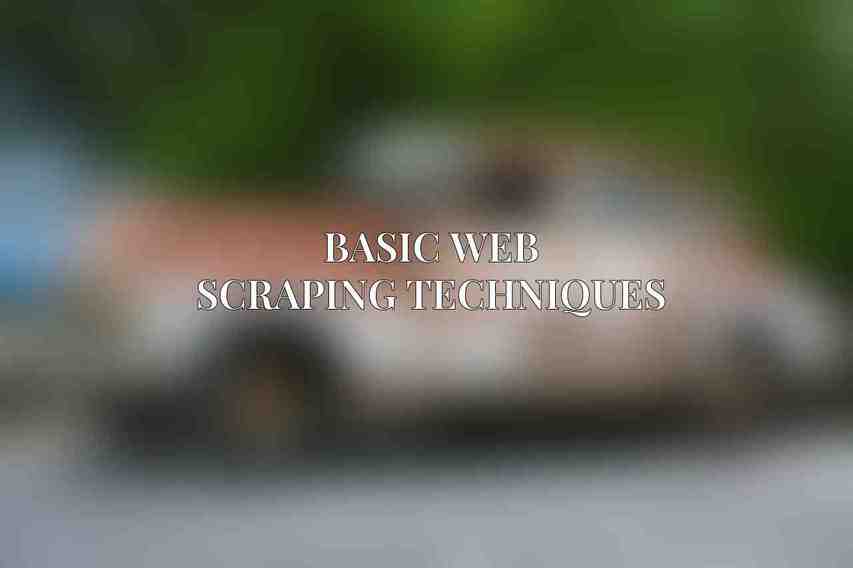Web scraping is the process of extracting data from websites. By automating the data extraction process, web scraping allows users to gather large amounts of information quickly and efficiently. Web scraping has become an essential tool for businesses, researchers, and developers in various industries.
Definition and Overview
Web scraping involves parsing HTML code to extract the desired data elements. It allows users to access information that is not readily available through APIs or databases. Web scraping is commonly used for tasks such as monitoring prices, collecting contact information, or aggregating news articles.
Benefits and Applications

The benefits of web scraping are vast. It enables businesses to gather competitive intelligence, track trends, and automate mundane tasks. Researchers can use web scraping to collect data for analysis, while developers can utilize it to create new applications and services.
Ethical Considerations
While web scraping offers numerous advantages, it is essential to consider ethical boundaries. Users must respect the website’s terms of service, avoid overloading servers with excessive requests, and refrain from scraping sensitive or personal data without consent.
Basic Web Scraping Techniques

Basic web scraping techniques involve HTML parsing and HTTP requests to retrieve and extract data from web pages.
HTML Parsing
- HTML Structure and Tags: Understanding the structure of HTML elements is crucial for targeting specific data.
- DOM Manipulation (Beautiful Soup, lxml): Tools like Beautiful Soup and lxml help parse and navigate the HTML document efficiently.
HTTP Requests
- GET and POST Requests: Different types of HTTP requests are used to retrieve web pages and submit forms.
- Headers and Cookies: Manipulating headers and cookies can help simulate human behavior during scraping tasks.
- Browser Emulation (Selenium): Selenium allows for automated interaction with websites, including handling JavaScript elements.
Advanced Web Scraping Techniques
Advanced web scraping techniques focus on handling dynamic content and refining data extraction processes.
Dynamic Content Handling
- AJAX and JavaScript: Techniques for handling asynchronous requests and dynamic content loading.
- Page Rendering and Headless Browsers (Puppeteer, Splash): Tools like Puppeteer and Splash help render JavaScript-dependent pages and interact with dynamic elements.
Data Extraction and Cleaning
- Regular Expressions: Regex is used for pattern matching and extracting data based on specific criteria.
- XPath and CSS Selectors: XPath and CSS selectors provide precise ways to locate elements within an HTML document.
- Data Validation and Normalization: Ensuring extracted data is accurate and formatted correctly for analysis.
Best Practices for Effective Web Scraping
To ensure efficient and ethical web scraping practices, adhering to best practices is essential.
Website Analysis and Understanding
Understanding a website’s structure and data layout is crucial for efficient scraping.
Rate Limiting and Respecting Robots.txt
Adhering to rate limits and respecting robots.txt directives helps maintain a good relationship with website owners.
Proxy Management for IP Rotation
Using proxies and rotating IPs can prevent IP blocking and enhance scraping anonymity.
Error Handling and Exception Management
Implementing robust error handling mechanisms ensures smooth scraping operations on various websites.
Advanced Web Scraping Tools and Libraries
Several programming libraries and tools are available to streamline web scraping tasks.
Python Libraries
- Scrapy: A powerful and scalable web scraping framework.
- Requests-HTML: Simplifies making HTTP requests and parsing HTML content.
- Selenium: Ideal for tasks requiring browser automation and dynamic content handling.
Java Libraries
- JSoup: Java library for parsing HTML documents.
- HtmlUnit: Provides programmatic web browsing capabilities.
- ZenRows: Java scraping library for efficiently extracting data from websites.
Cloud-Based Services
- Amazon Web Services (AWS) Data Scraping: Utilizing AWS for scalable and distributed web scraping tasks.
- Google Cloud Platform (GCP) Data Scraping: GCP offers cloud-based solutions for data extraction and analysis.
Case Studies and Applications
Web scraping finds diverse applications across industries, with real-world case studies illustrating its versatility.
Real Estate Data Extraction
Scraping real estate websites enables the collection of property listings, prices, and market trends for analysis.
Product Data Collection for E-commerce
E-commerce businesses utilize web scraping to monitor competitor prices, track product availability, and optimize pricing strategies.
Market Research and Data Analysis
Web scraping plays a vital role in gathering market data, consumer sentiment analysis, and industry trends for informed decision-making. Learn more about How to Build Your First Web Scraper: A Step-by-Step Guide
mastering essential web scraping techniques is key to extracting data effectively from the web. By combining basic and advanced scraping methods with best practices and utilizing appropriate tools and libraries, users can harness the power of web scraping for various applications.
Summary of Key Techniques
Web scraping techniques cover HTML parsing, HTTP requests, dynamic content handling, data extraction, and cleaning practices. Dive deeper into Top Web Scraping Tools of 2024: Expert Reviews & Comparisons
Future Trends and Advancements
As web technologies evolve, web scraping tools and techniques will continue to advance, offering more efficient and versatile solutions for data extraction tasks.
Resources for Further Learning
For those interested in delving deeper into web scraping, numerous online resources, tutorials, and communities exist to support continuous learning and skill development in this field.
By leveraging the insights and skills gained from mastering web scraping techniques, individuals and businesses can unlock a wealth of data-driven opportunities and drive innovation in their respective domains.
Frequently Asked Questions
What is web scraping?
Web scraping is the process of extracting data from websites. It involves using automated tools to access and retrieve information from web pages.
Why is web scraping important?
Web scraping allows you to retrieve valuable data from the internet for various purposes such as market research, competitor analysis, and lead generation.
What are some popular web scraping tools?
Some popular web scraping tools include BeautifulSoup, Scrapy, and Selenium. These tools offer various features for extracting data from websites.
Is web scraping legal?
The legality of web scraping depends on how the data is used. It is generally allowed for personal use, but some websites have rules against automated data extraction. Explore further with Navigating the Legal Landscape of Web Scraping: Ethical Considerations & Best Practices
What are some best practices for effective web scraping?
Some best practices for effective web scraping include respecting website terms of service, being mindful of the website’s robots.txt file, and monitoring your scraping activities to avoid overloading servers.

